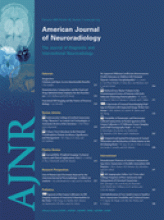Abstract
BACKGROUND AND PURPOSE: To our knowledge, very few MR imaging data have been reported in isolated cortical venous thrombosis (ICoVT). The purpose of this study was to describe MR imaging features, including T2*gradient-echo (GE) sequence, in presumed ICoVT.
MATERIALS AND METHODS: MR imaging examinations were performed in 8 patients with ICoVT (MR venography was performed in all patients and digital substraction angiography in 4) at the time of diagnosis and during the follow-up at 15 days (4 patients) and at 3 (8 patients), 6 (6 patients), 12 (3 patients), and 18 months (1 patient). We assessed the presence of a magnetic susceptibility effect (MSE) on T2*GE imaging at each site of cerebral venous thrombosis and the presence or absence of a normal flow void and iso-, hypo-, or hyperintense signal intensity on T1, T2, diffusion-weighted imaging (DWI), and fluid-attenuated inversion recovery (FLAIR) images. Parenchymal signal-intensity changes were also assessed on the same sequences.
RESULTS: MSE was detected on T2*GE imaging at the site of a cortical vein in all subjects at the first MR imaging examination. The occluded vein appeared as hyperintense in 3 patients, iso- to slightly hyperintense in 1 on T1, hypointense in 6 on FLAIR images, and as signal-intensity loss on DWI in 3. At follow-up, persisting signal-intensity abnormalities on T2*GE imaging were detected at the venous sites in all patients, whereas signal-intensity changes on T1- and T2-weighted images were no longer present. Parenchymal hyperintensities on FLAIR and DWI (increased apparent diffusion coefficient [ADC]) were observed in close vicinity to the thrombosis in 6/8 patients. Petechial hemorrhages (n = 3) or hematoma (n = 2) was present on T2*GE imaging in 5/8 patients. During the follow-up, all cerebral tissue signal-intensity changes on T1, T2, and FLAIR images decreased both in volume and intensity. ADC values normalized within the tissue after 3 months in all patients.
CONCLUSIONS: On T2*GE imaging, MSE of hemoglobin products within the thrombus was observed both at the early and late phases of ICoVT and appears to be of high diagnostic value compared with the other signal intensity changes detected on standard MR imaging.
- Copyright © American Society of Neuroradiology












